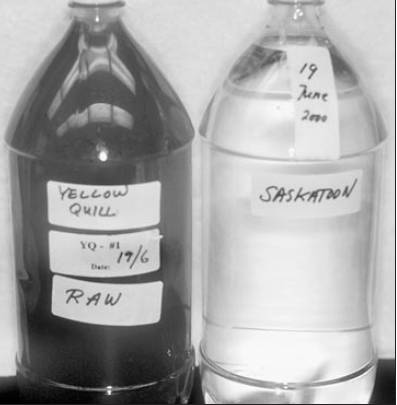Rural water quality
offers perspective
By Hans Peterson (From the Star Phoenix, July 21, 2005 (with permission)
Following is the personal viewpoint of the writer, executive director of the Safe Drinking Water Foundation.
When Calgary and Saskatoon get a whiff of a challenge in their raw water, it makes national news.
Consider this. It takes Calgary around six hours to produce safe drinking water from its extremely good quality raw water. It takes around two hours for Saskatoon to do the same thing with generally high quality raw water from the South Saskatchewan River.
The accompanying photo shows a side-by-side comparison of samples taken on the same day from the raw water supply for the Yellow Quill First Nation and from the South Saskatchewan River. Yellow Quill was under a boil water advisory for nine years as it tried to treat this truly challenging source water, which also had an upstream community discharging its sewage lagoon into it.
Yellow Quill was supposed to make drinking water from this within minutes rather than hours. In that, it’s similar to most rural Saskatchewan communities, which have appalling water to treat. Many use water treatment processes that have no hope of ever making safe drinking water.
In order to pass as drinking water, Saskatchewan has had to triple the allowable levels of total dissolved solids to 1,500 milligrams per litre, while in the rest of Canada and the world upper limit is 500 mg/L. While this level is an “aesthetic” guideline, high levels of dissolved solids in Saskatchewan’s groundwater sources are often associated with problem compounds such as dissolved organics, iron, manganese, ammonium and arsenic, all of which pose challenges for water plant operators.
If we have close-to-pristine water to treat, as do Saskatoon and Calgary, the current state of engineering in rural Saskatchewan may be considered passable. But with sewage and manure as well as organic material from terrestrial and aquatic vegetation tainting rural water sources, many water treatment systems are completely inadequate.
This is especially a concern in Saskatchewan, where we have institutionalized inadequate rural wastewater systems. Even Saskatchewan Environment’s own documentation shows that spring discharges from rural lagoons fail to meet any kind of effluent guidelines, thus increasing the risk of contaminating drinking water.
When drinking water is contaminated by human sewage, the main issue becomes viruses. But, in rural Saskatchewan government agencies have hung their hats on indicators of bacteria and coliform testing. However, while chlorination rapidly will inactivate or kill coliforms, other disease-causing bugs are far more difficult to kill.
The simple solution has become to add more chlorine and believe in the imaginary powers of “coliform testing.” Failure to meet the coliform test is punished with boil water advisories.
At an international Safe Drinking Water Foundation (SDWF) conference last fall, Dr. Colin Fricker noted that government regulatory coliform testing does absolutely nothing to ensure water is safe.
The reason is that most waterborne disease outbreaks in developed countries aren’t associated with coliforms.
While hepatitis A contamination of well water was one of the main concerns that prompted the U.S. Environmental Protection Agency to implement a tough new “Groundwater Rule,” Saskatchewan went so far to state that hepatitis A is only waterborne in developing countries.
The United Nations has established that 80 per cent of all disease in developing nations is caused by water. Neither Health Canada nor the provincial Health Department has dared to make such a comparison for rural Saskatchewan; I guess it’s simpler to pump ever increasing dollars into the health-care system.
Even in countries with more stringent regulations than Canada, such as the U.S., virtually all water treatment plant failures (95 per cent or more) happen in small communities. It can be assumed that waterborne disease is mainly a rural phenomenon in developed countries.
Faced with challenges, government agencies promote the construction of long pipelines from “good quality water sources” and ignore the microbial problems caused by transporting water over vast distances. Developing water treatment processes that can effectively treat poor quality water will be less expensive and provide better quality drinking water than what government “pipe dreams” will achieve.
Government agencies have to stop conveniently ignoring selective facts so that they can claim the water is safe. It requires the use, rather than the abuse, of science.
For water quality information backed by science rather than politics visit www.safewater.org.
As Goethe wrote: “Knowing is not enough; we must apply. Willing is not enough; we must do.”

